Bartlett Staff and Alumni Feature at the Venice Architecture Biennale
10 May 2021
Architects and designers from The Bartlett School of Architecture will exhibit their work at the 17th Venice Architecture Biennale. The Biennale takes place this year from 22 May to 21 November, rescheduled from 2020 due to the pandemic.
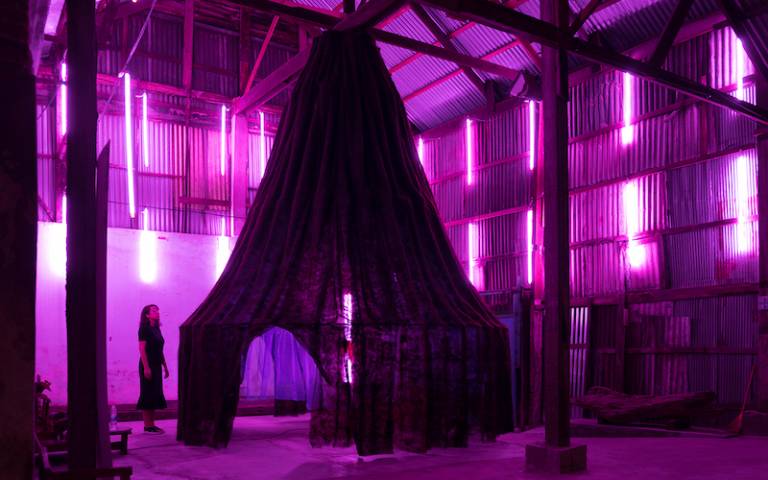
This year’s International Architecture Exhibition is titled ‘How Will We Live Together?’ and is curated by architect and scholar Hashim Sarkis. Bartlett staff and alumni are represented across a number of national pavilions as well as participating in the main exhibition.
Bartlett projects
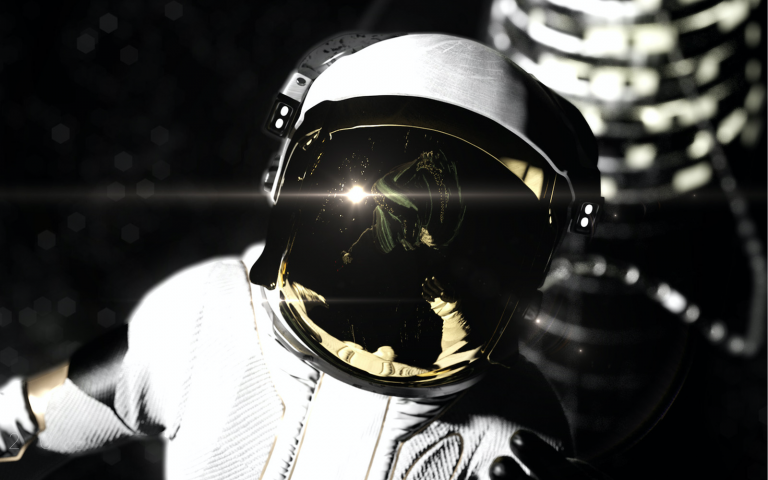
Prof Marjan Colletti will take part in the Italian Virtual Pavilion, Sezione del Padiglione Italia, as one of the Creative Directors for the exhibition titled ‘CityX Venice’. The Italian Virtual Pavilion will consist of an online exhibition, lectures, workshops, and roundtable discussion to draw the world’s leading researchers together sharing ideas, thinking, and imagination necessary to re-set the future.
Marjan’s transdisciplinary project ‘Space-Architecture-Space’ will bring together leading creative researchers (architects, engineers, artists, scientists, performers and coders ) from across UCL and the wider international community. The project investigates how architecture and space influence and advance each other, aiming to identify new areas of knowledge, reimagining the future of space programmes and developing design responses and solutions for human life on Earth and beyond.
Other Bartlett and UCL participants in ‘Space-Architecture-Space’ include Prof Marcos Cruz and Dr Brenda Parker (Bio-Integrated Design MArch/MSc), Roberto Bottazzi, Tasos Varoudis, and Enriqueta Llabres-Valls (Urban Design MArch), Fiona Zisch and Dr Ruairi Glynn (Design for Performance & Interaction MArch) and Prof Alan Smith and Dr Iya Whiteley (UCL Space Domain/Space & Climate Physics/Architecture MPhil/PhD).
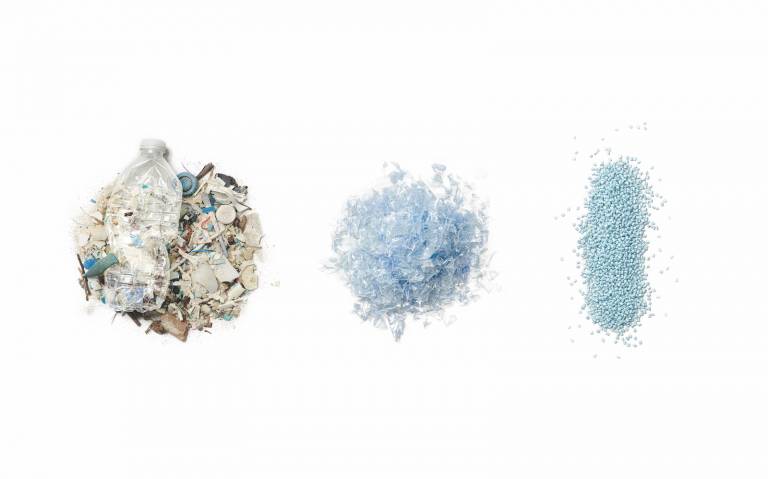
MPhil/PhD student Niccolò Casas has produced an installation for the Italian Pavilion in collaboration with environmental organisation Parley for the Oceans. Constructed with the 3D-printing company Nagami, ‘Plasticity’ is made from Parley Ocean Plastic®, a catalyst material created from up-cycled marine plastic waste that has been intercepted from remote islands, beaches and coastal communities. The sculpture points to the potential of recycling processes to combine with innovative digital design and digital fabrication.
‘Plasticity’ highlight notions of transformation and conversion. In architecture, the term refers to the quality of a work to freely articulate in space. Formally, the sculpture stems from a combination of two oppositional lexicons: an organic one reminding us of natural, free formations and a linear, geometric one, becoming a metaphor of the uncompromised twofold human-nature.
Niccolò Casas is an MPhil/PhD student at the school, researching ‘Digital Decadence – The aesthetics of Ugliness in the age of digital architecture’.
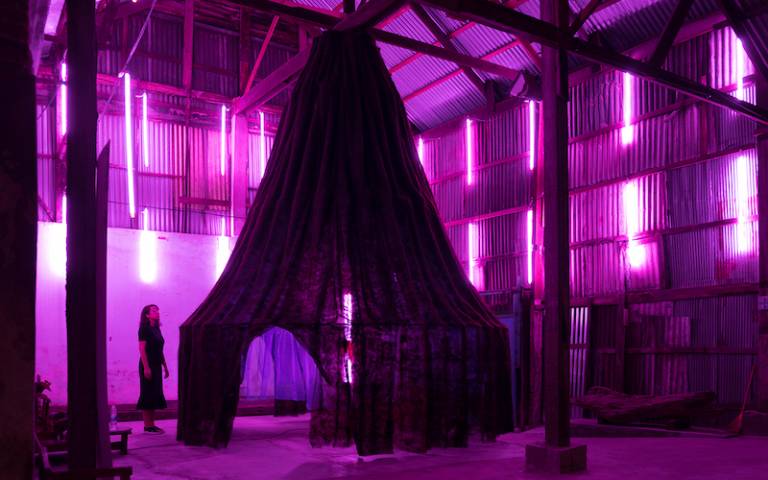
Pareid (Déborah López and Hadin Charbel) are exhibiting at the Spanish Pavilion. ‘Follicle. A Toxi-Cartographic proposal for Bangkok’ is a pavilion that examines the relationship between a city's inhabitants and environmental toxicity through the collection and analysis of human hair. The pavilion invites users to anonymously participate by providing hair samples to be tested for heavy metals, the results of which are made publicly available on an interactive website in the form of a toxi-cartography. The project addresses evolving social and environmental architectures and provokes questions of aesthetics and autonomy.
Déborah López and Hadin Charbel are both Lecturers (Teaching) on The Bartlett’s Architectural Design MArch with Research Cluster 1, ‘Monumental Wastelands’. They also tutor on the MEng Unit 3.
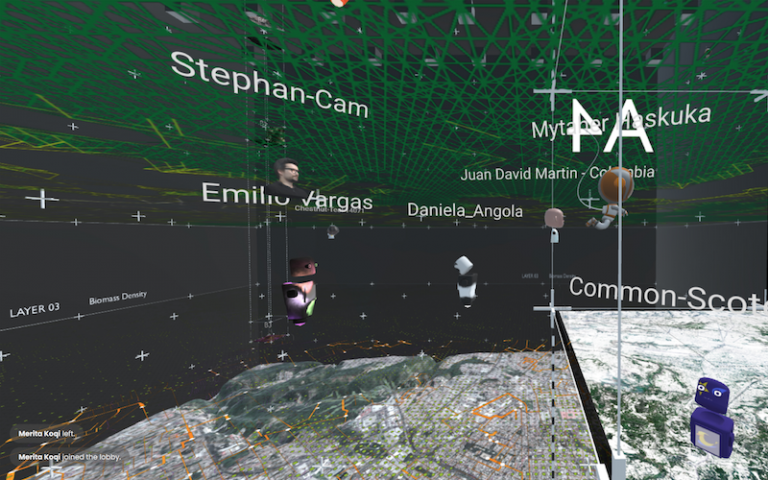
Dr Claudia Pasquero and Dr Marco Poletto will present two projects at the Biennale. ‘BIT.BIO.BOT’ will be in the main curator exhibition in the Corderie, and will explore re-greening our cities and our architecture in the face of ecological crisis. They will also present a video, ‘Urbansphere’, in the Italian Pavilion, proposing that the increased spatial integration of non-human systems within architecture is crucial to evolve higher forms of urban ecological intelligence.
‘BIT.BIO.BOT.’
The ‘BIT.BIO.BOT.’ installation is a 1:1 scale experiment into the cultivation of the urban microbiome, testing a model of permanent co-existence between human and non-human organisms in the post-pandemic urban environment. The installation is a real urban laboratory that combines advanced architecture with microbiology to build an artificial habitat, a prototype dwelling where urban algae can be grown collectively. Teachers and school pupils from several schools from the Tirolean (?) region will be involved in the design and production of the unique bioreactors’ habitats. At the end of the Biennale each cultivation unit will become an educational algae garden and find its permanent location at the multiple participating schools and research institutions. The microbiological gardens will be part of biology labs and educational programs on urban air quality and future food.
‘Urbansphere’
In this project, obsolete notions are substituted by algorithms, digital and biologic, that process information relayed by distributed sensing technologies that can render both the surface and the deep structure of our cities at increasingly high resolution. A new urban landscape emerges which we design but don't fully determine, as what we draw, fabricate or grow is mediated by the combined intelligence of our digital and biological machines, all interacting in actual space and real-time. The Urbansphere Installation will embody a prototype for a future bio-digital infrastructure.
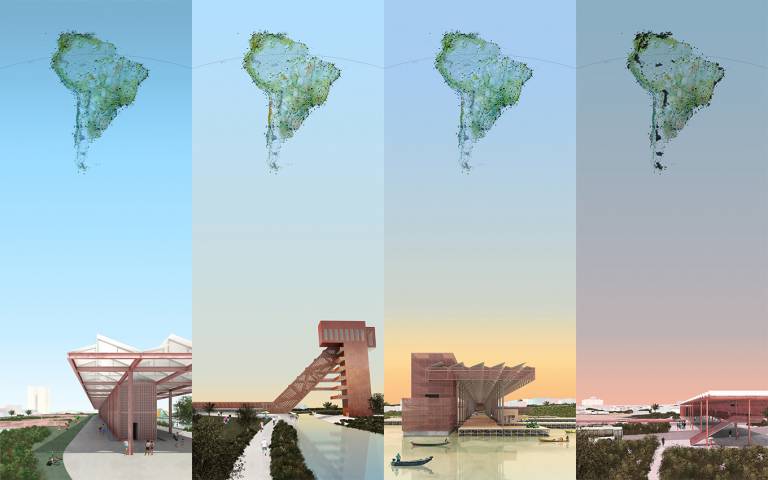
Katie Kasabalis, Konstantina Tzemou, Evan Shieh, Sze Wai Justin Kong, Inhwi Hwang and Chengxin Sha will exhibit in the Central Pavilion in the Giardini, with ‘Manaus: A New Contractual Agreement between City and Forest in Urban Amazonia’, a project created in collaboration with Anthony Acciavatti, Felipe Correa and Devin Dobrowolski of Somatic Collaborative. Through a specific design project sited at the confluence of three rivers (Black, Amazon, and Mindú), Manaus argues for a new contractual agreement between city and territory by looking beyond the traditional definitions of cities and what constitutes the urban in the context of the Amazon Rainforest.
Sited along the Mindú River, a spine that connects the Black River to the Reserva Florestal Adolpho Ducke, the project proposes a series of urban interventions that forge a new civic infrastructure fostering social and economic cooperation between the cycles of the river, forest, and city. Through the careful examination of five archetypal elements—the tower, the mat, the linear bar, the island, and the bridge—the project proposes an urban imaginary that advocates for the co-existence of ecological conservation and urban development, tempering the harsh divide between city and forest in the Amazonian region.
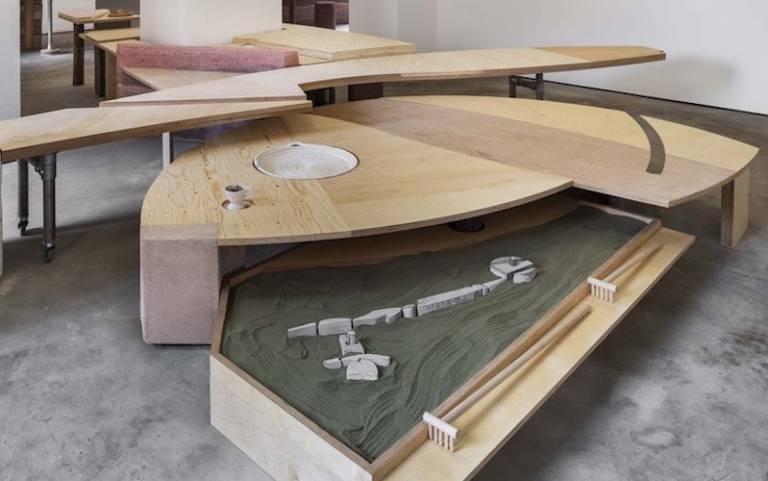
Era Savvides and Nasios Varnavas (Urban Radicals) are the designers and co-curators for the Cypriot Pavilion, collaborating with independent curators Evagoras Vanezis and Marina Christodoulidou.
'Anachoresis: Upon Inhabiting Distances' takes the form of a large table spanning through the pavilion's space, exploring the social dimensions, narratives and perceptions that occur when distancing becomes a paradigm for the development of new socialities and architectures for living together. Themes of collectivity through craft, materiality, gathering, community and play are further explored and unpacked through the architecture of the table - structures, legs, fragmented countertops, and moving parts as well activating objects.
Additionally to this work, the team has selected 12 young emerging architects and multidisciplinary collectives from Cyprus and abroad, through an open call, to contribute to the project with scaled models which are displayed on the table's surface, inviting further reflections on the physical and social aspects of architectural practice when protocols of distancing are applied.
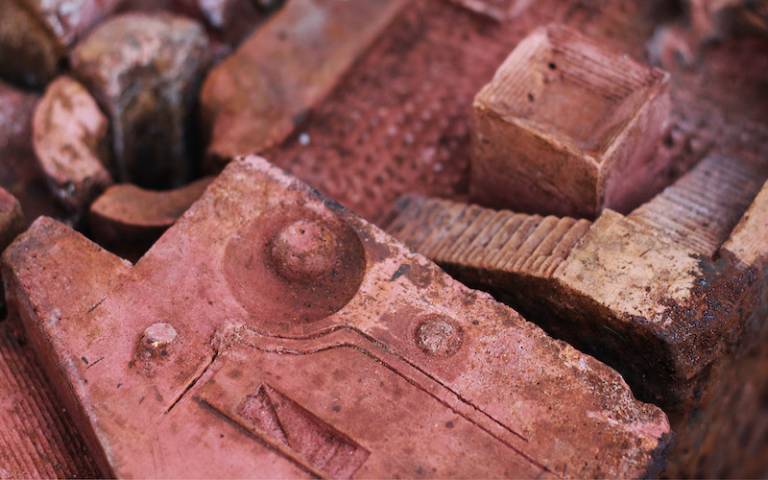
Serhan & Thanasis (Serhan Ahmet Tekbaş and Thanasis Ikonomou) will exhibit 'Artifact 126: The Firepit' in the Cypriot Pavilion, curated by Marina Christodoulidou, Era Savvides, Evagoras Vanezis, and Nasios Varnavas. The collaborative duo are engaged with Cypriot architecture and design, interested in architecture as a medium to tell physical novels and speculating architectures that look back at history and towards the future at the same time.
Historically, the relationship between fire and fiction has been closely bound as a device to ignite the imagination of storytellers and listeners alike. In the winter season of 2021 Artifact 126: The Firepit was discovered between the red cliffs and olive orchards in Boltaş Köy, Kuzey Kibris. Designed as a disjecta membra, the ruinous fragments of what was once a firepit offers grounds for the collective imagination of both the viewer and architect.
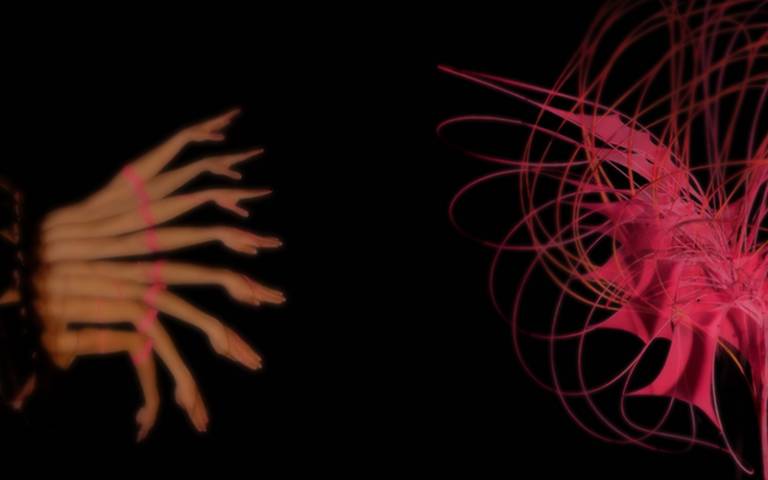
Valentina Soana is exhibiting ‘ELAbody’ with Vijay M Pawar and Robert Stuart-Smith from the Automated Manufacturing Lab at UCL. They will exhibit in the Italian Pavilion under the theme ‘Resilient Communities’, curated by Alessandro Melis, within Antonino Di Raimo’s Architecture as Caregiver area.
‘ELAbody’ is an elastic robotic structure performing as a column and exoskeleton. The actuated system is connected to the human body, inviting it to perform specific movements. The human body is pushed and pulled to stretch and bend in response to elastic structural deformations. Performances are controlled by robotic rhythms and frequencies. This project is part of a wider research agenda at the intersection of architecture and engineering, combining material and robotic intelligence to develop novel dynamic structures.
At a conceptual level, this research explores the role of robotics in architecture, moving beyond their role as tools, towards the notion of robotic spaces, structures and building systems. This approach opens new interaction scenarios between human, material and machine systems. In ELAbody, transformations are triggered by tension and cooperation between the robotic actuators and human body movements. From this exchange of forces emerges novel performances.
Research collaborator: Shahram Minooee Sabery @minooey (BSA, UCL)
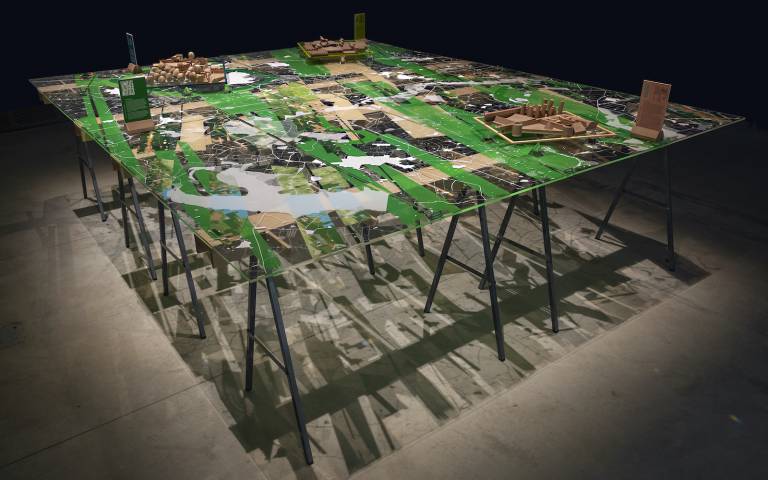
Professor Laura Allen and Professor Mark Smout (Smout Allen) have made two contributions: ‘Rescue Lines’, an installation for the Giardini Central Pavilion in collaboration with LA based author and curator Geoff Manaugh, and a contribution to Future Assembly, curated by Olafur Eliasson and Studio Other Spaces.
Rescue Lines
‘Rescue Lines’ proposes a world in which the forests of the United Kingdom, both ancient and modern, can be expanded, restored, and connected once again. The project takes the form of a series of south-to-north ecological bridges—linear super-landscapes—along which displaced or endangered species can safely travel and threatened human economies can thrive.
The project, presented as a large map table and 1:200 wooden models, explores the future of green infrastructure through the lives of those who engage with it. Rescue Lines connects ecological zones and economic territories at the same time, suggesting that longitudinal lines of connection, bridging forests across the United Kingdom as a model for sites elsewhere, can help us all prepare—hectare by hectare—for a climate-changed world.
Future Assembly
Future Assembly’s “collective exhibition within the Exhibition” charts a living collection of attempts by humans to recognise and secure the rights of nature during the 75-year history of the UN Charter and spurs the question: what will the next 75 years bring? Smout Allen's contribution nominates Hedgerows, semi-natural environments with a vital environmental role, as a more-than-human stakeholder in the future UN assembly.
Research Assistants: Vanessa Lafoy, Doug John Miller and Matei Alexandru
Specialist joinery: Mauro Dell’Orco at Workshop East
Prof Adrian Forty has also contributed to two publications that will be launched at the Biennale; a short essay in a book about the history of the Nordic pavilion, and a contribution to a publication around Sauerbruck Hutton’s new museum in Mestre which launches at the same time as the Venice Biennale.
If you’re a Bartlett academic, alumnus or student exhibiting at the Venice Architecture Biennale, and would like to be added to this page, please email The Bartlett Comms team at architecture.comms@ucl.ac.uk with some information about your participation – including a short project description, a landscape image, which pavilion the project is sited in, and the names of any colleagues involved.
Image credits
1: Theodoros Tamvakis, PG20 2019/20
2: Parley for the Oceans
3: Foll(i)cle - a pavilion made of discarded human hair that invites the public to participate in a protocol for creating a toxi-cartography of the city - by Pareid.
4: DeepGreen VR room workshop - by ecoLogicStudio with The Bartlett, UCL and Innsbruck University for UNDP (United Nation Developing Program) and Guatemala City
5: Somatic Collaborative
6: Disjecta Membrane - by Serhan Ahmet Tekbaş
7: ELAbody dynamic performance - by Valentina Soana (AML,BSA,UCL)
8: Rescue Lines - by Smout Allen
 Close
Close

